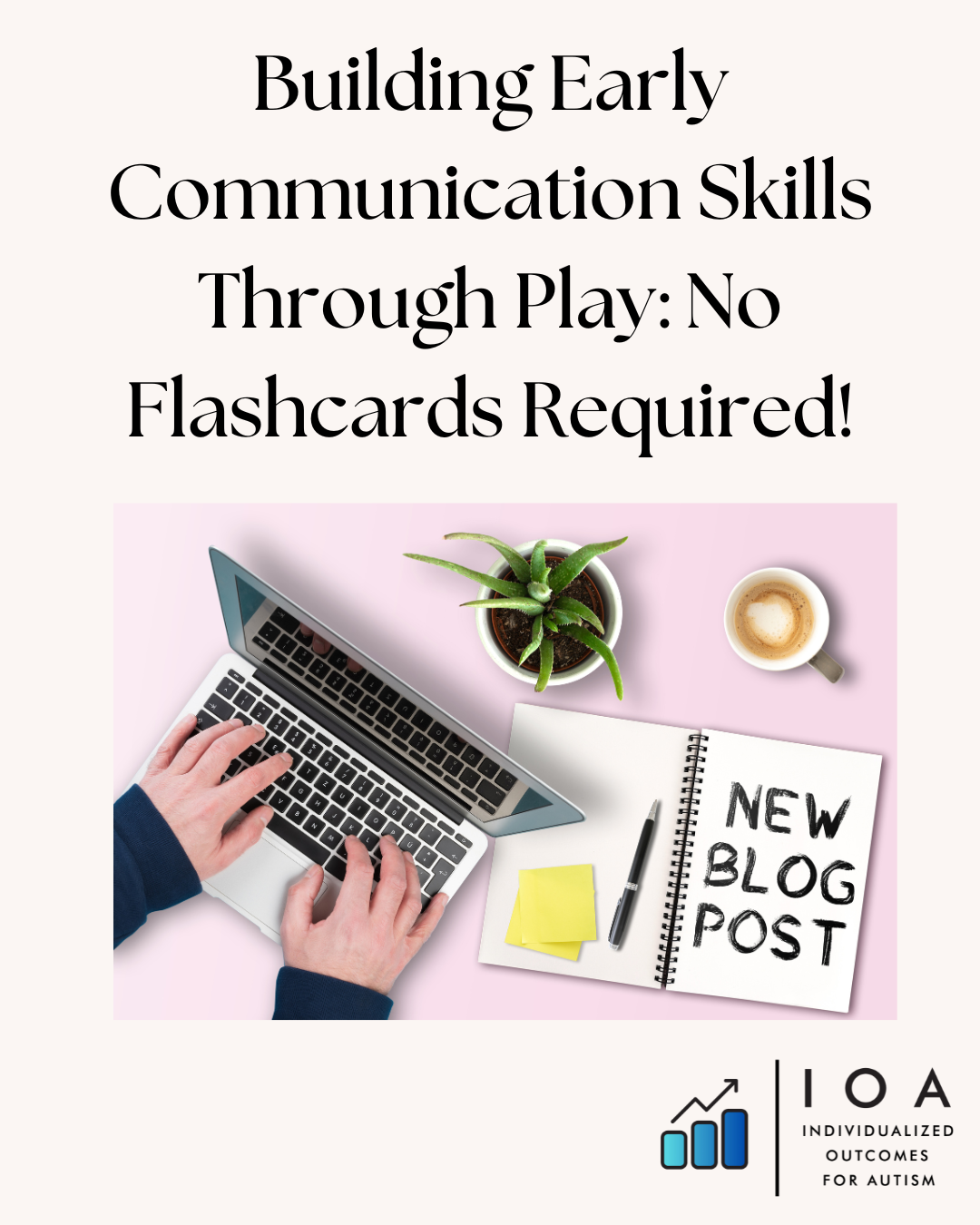Building Early Communication Skills Through Play: No Flashcards Required!
Angela Khater, BCBA
When my son was diagnosed with a language delay at 2, the therapist handed me a stack of worksheets and picture cards. You know what happened to those fancy materials? They ended up stuffed in a drawer while we figured out what actually worked. What actually worked was play.
Turns out, those unstructured silly moments, racing trucks down hallways, having dance parties, or just making ridiculous noises back and forth did more for his communication than any formal “lesson” ever could. As both a mom and a BCBA, I’ve seen this pattern repeat with countless children.
The Magic Connection Between Play and Communication
Here’s what nobody tells you in those parenting books. Play isn’t just something kids do for fun. It’s their primary language, their work, and their way of making sense of the world. When we tap into play, we’re essentially speaking their native tongue.
I remember watching a nonverbal 4 year-old in my clinic who showed zero interest in structured communication activities. But put him in front of a sensory bin with dinosaurs? Suddenly we got eye contact, pointing, and even some approximated words like “rawr!” That’s the power of following a child’s interests.
Ditch the Lesson Plans (Sometimes)
Don’t get me wrong, structured teaching has its place. But some of the best communication breakthroughs happen during child-led play when we:
Get down on the floor (yes, literally, your knees might hate you, but your kid will love it)
Follow their lead instead of directing the action
Create slight communication “temptations” within their favorite activities
Focus on connection over correction
I’ll never forget observing a mom who spent 30 frustrating minutes trying to get her daughter to label pictures of food. Switch to pretending to cook with the same foods? The child started spontaneously naming everything in the play kitchen.
Practical Play Ideas That Actually Build Communication
Let’s get real, you need activities that work in everyday life, not perfect Instagram-worthy setups. Here are some no-fuss ways to build communication through play that have worked for families I’ve supported:
For Babies and Young Toddlers:
Back-and-forth games like peekaboo with silly sounds (builds turn-taking, the foundation of conversation)
“Accidentally” getting favorite toys stuck in clear containers (creates natural requesting opportunities)
Singing songs with movements, then pausing before the fun part (builds anticipation and encourages vocalization)
For Toddlers and Preschoolers:
Toy sabotage, giving them bubbles with the lid screwed on tight or cars that need batteries (creates natural asking for help)
Obstacle courses with directions or silly movement words (“jump,” “wiggle,” “crash!”)
Pretend play with focused themes, doctor’s office, grocery store, restaurant (builds vocabulary in meaningful contexts)
For Older Kids:
Board games with modified rules that encourage describing, explaining, or storytelling
Scavenger hunts where they need to give and receive specific clues
Building projects where they need to request specific materials
What This Looks Like in Real Life
One of my favorite success stories involves a 5-year-old boy who primarily echoed phrases from TV shows. Traditional speech therapy wasn’t clicking, so we tried something different.
We noticed his obsession with trains and created a track setup with missing pieces. To get each piece, he needed to use a specific phrase. We didn’t drill these phrases, we just modeled them naturally during play. “I need a straight track!” or “The blue train goes here!”
Within weeks, he was spontaneously using these phrases in new contexts. By three months, he was creating novel sentences and genuinely communicating, not just memorizing scripts.
When Your Child Doesn’t Seem Interested in Playing
“But my child doesn’t play appropriately,” I hear this often, and it’s a valid concern. If your child lines up toys, fixates on parts of objects, or seems uninterested in typical play, don’t panic. Start where they are:
Join their repetitive play without trying to change it initially (line up those cars alongside them!)
Slowly introduce small variations (maybe one car drives off the line?)
Add sensory elements that increase engagement (kinetic sand, water play, movement)
Find their “currency” what truly motivates them, even if it’s not a typical toy
One little girl I worked with only wanted to spin the wheels on cars. Rather than stop this behavior, her mom started spinning them too, then gradually introduced spinning games with her body, then spinning down ramps and eventually, this expanded into broader play skills and communication.
The Parent/Professional Partnership
As someone who’s been on both sides, the worried parent and the professional. I firmly believe that parents are the most powerful communication teachers. You don’t need special training, just intentionality and these simple strategies:
Notice what excites your child and expand on it
Create natural communication opportunities within favorite activities
Respond to ALL communication attempts, even unconventional ones
Model language slightly above their current level
Prioritize fun and connection over “getting it right”
Remember those worksheets that ended up in my drawer? Eventually, we did use some of them but only after we’d established play as our primary connection point. Once my son associated communication with positive interactions, the more structured work came much easier.
The Bottom Line
Building communication through play isn’t just more fun, research shows it’s more effective and leads to better generalization of skills. When children learn language in natural, motivating contexts, they’re more likely to actually use those skills across different settings.
So pack away the flashcards (or at least set them aside temporarily). Get a little silly, follow your child’s lead, and watch communication blossom through the universal language of play. Your living room floor might get messier, but the connections you build will be worth it.

